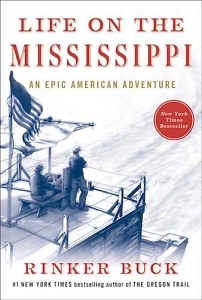Big River
Rinker Buck navigates turbulent swells and history in Life on the Mississippi
When Rinker Buck, the Tennessee-based author of Life on the Mississippi: An Epic American Adventure, told his brother that he planned to build a flatboat and float it down the Ohio River from West Virginia to the Mississippi and then on to New Orleans, the seasoned Coast Guard veteran replied, “Rinker … you’re going to die.” This becomes a refrain repeated by a wide variety of river experts encountered in Buck’s informative and highly readable account of his 2,000-mile journey downstream.

Although he doesn’t die, the trip proves an epic adventure worthy of the book’s subtitle. Buck learns and relearns lessons in small boat navigation while battling storms, sandbars, whirlpools, flood surges, and endless strings of barges pushed by behemoth tugs. He breaks ribs on more than one occasion.
As a teenager, Buck learned to navigate small aircraft by rivers in a cross-country flying trip with one of his brothers. This evidently instilled in him the courage to navigate dangerous rivers from the vantage point of 19th-century settlers and merchants. Throughout the book, he deadpans lines like, “Jumping into the current with a heavy coil of rope on my shoulder proved a useful educational experience.”
After setting his mind on the trip, Buck is convinced by a YouTube video to hire John Cooper of Gallatin, Tennessee, to build his flatboat, which Buck ultimately christens Patience. He describes the blocky wooden craft as “a shit-rigging masterpiece, my hillbilly Pequod, my floating jalopy, my personal Kon-Tiki, a gorgeous code violation that would carry me south to New Orleans.” While Cooper had built several previous flatboats for historical reenactments, he had never constructed one designed to survive the rigors of a 2,000-mile journey. The boat thus becomes a continuously modified experiment.
 A flatboat historian named John McDermott wrote in a 1967 essay that in the early 19th century, “one took whatever crew was available.” Buck takes this line as permission to do the same, rotating a ragtag assortment of helpers on and off the boat as their time and inclination allow. With this parade of enthusiasts and part-time crew, Buck and his hyperactive first mate Dan Corjulo (who frequently leaves the Patience for stints at his day job in Connecticut) spend days tinkering with dock bumpers, anchors, gasoline storage, and other small improvements to avoid misadventure.
A flatboat historian named John McDermott wrote in a 1967 essay that in the early 19th century, “one took whatever crew was available.” Buck takes this line as permission to do the same, rotating a ragtag assortment of helpers on and off the boat as their time and inclination allow. With this parade of enthusiasts and part-time crew, Buck and his hyperactive first mate Dan Corjulo (who frequently leaves the Patience for stints at his day job in Connecticut) spend days tinkering with dock bumpers, anchors, gasoline storage, and other small improvements to avoid misadventure.
In addition to relating the many hazards of the trip, Buck shares history tied to vivid descriptions of spots passed along the way. The boat drifts by an eerily abandoned mill in Weirton, West Virginia, a place that had been hopping with activity when Buck visited it while writing a 1983 Life article about the collapse of the American steel industry. Trees sprout from smokestacks and rusting ore carts.
“Along the Rust Belt landscape of the inland rivers,” Buck observes, “the persistence of man was dramatically yielding to the persistence of nature.”
The team explores barge towns like Newburg, Ohio, and New Madrid, Missouri, where residents celebrate their river heritage but never dare to enter the treacherous waters themselves. Buck finds invariably interesting local characters, describing them in the manner of John McPhee or William Least Heat Moon.
The title Life on the Mississippi is, of course, taken from Mark Twain, and Twain reverberates throughout the river adventure, along with lines of poetry and songs composed by other 19th century writers. Yet Buck’s easy command of history, keen travel observations, and self-deprecating humor (often arising from potentially life-threatening situations) especially evokes the work of Bill Bryson.
Critic Dwight Garner mentioned Bryson in describing Buck’s best-known book, The Oregon Trail, which spent 16 weeks on the New York Times bestseller list in 2015. The comparison is apt, but in some ways Buck on the Mississippi goes further than Bryson in Appalachia. Beyond scenes of comedy and danger on the river, beyond history and insightful contemporary observation, Life on the Mississippi remains at heart a personal memoir. In quiet coves and riverbank camps, Buck describes the recent loss of his talented mother, the difficult father whose hard lessons wind up helping him on the river, and his rambunctious herd of now-aging siblings.
By the time Buck lands (somehow still breathing) in New Orleans, the reader knows not only much of the navigational history of the Ohio and Mississippi and their ongoing service to the national economy, but an interesting fellow, as well, someone worth following through further fat books of ill-advised adventure.

Michael Ray Taylor is the author of Hidden Nature and other books. He lives in Arkansas, where he is currently working on a novel.


